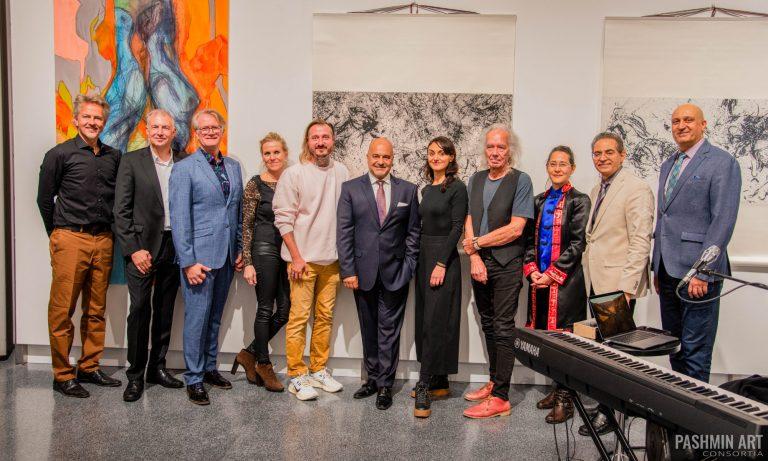Willem Vos’s Bird Series presents a deeply symbolic exploration of transformation, freedom, and renewal. Each bird featured in the series invites the viewer to reflect on the timeless symbolism that birds have held across cultures and literary traditions. Birds have long been associated with the ability to transcend the earthly realm, offering metaphors for the soul, freedom, and even divine messages. Vos, through his dynamic compositions and vibrant colors, continues this tradition by evoking the ethereal nature of birds as symbols of transformation and resilience.
The symbolism of birds, as Michael Ferber explains in A Dictionary of Literary Symbols (1999) (s.v. ‘Bird’), is often either metonymical or metaphorical. For instance, larks are associated with dawn, and swallows with the arrival of spring, because these birds are tied to these natural phenomena. In Vos’s work, however, the symbolism goes beyond simple associations; it delves into metaphorical territory, where each bird represents a deeper aspect of human experience, particularly the journey through change. As Ferber notes, birds “form a community which is independent of our own,” yet they also “appear to us like another society, homologous to that in which we live.”
In Fight Against Evil, Willem Vos employs powerful symbolism to evoke the classic theme of the struggle between light and darkness, good and evil. The white peacock stands in stark contrast to its dark and turbulent surroundings. White, associated with purity and goodness, represents the force of light, while the chaotic background signifies the opposing darkness. The title underscores the narrative of confrontation and bravery in the face of adversity, suggesting that the pride embodied by the peacock is linked to the valor found in fighting against evil. M. Ferber writes, “The peacock (Greek taos, Latin pavo) is striking for its large colorful tail that opens erect like a fan; as it struts about in full display the bird seems inordinately proud. It is not mentioned often in Greek literature (they were imported into the Mediterranean region from India), but in Latin literature the bird is sacred to Juno and a byword for beauty and pride.” This pride embodied by the peacock seems to relate not only to its inherent beauty but also to the valor found in the fight against evil.
Vos’s piece New Times, which features a bird navigating through swirling patterns of color, aligns with the metaphorical portrayal of birds as messengers of change. In literary tradition, birds have often been associated with divine messages or omens, as Ferber points out in his reference to “bird-augury” in ancient cultures, where the flight patterns of birds were interpreted as signs. In this work, the bird’s flight through a storm of colors mirrors the human experience of navigating life’s uncertainties. The swirling lines and vibrant hues suggest that, like the bird, we too must adapt to the shifting times, trusting in our ability to soar above the chaos.
The most powerful representation of renewal in Vos’s series is Rising from the Ashes, where a phoenix-like bird emerges from darkness. This image draws directly from the ancient myth of the phoenix, a bird that symbolizes rebirth and immortality. The concept of the phoenix, also known in Persian as Qoqnoos (and in Ancient Greek as Kýknos, Latin Cygnus, meaning swan in both languages), has been embraced across cultures, symbolizing themes of renewal, resurrection, and immortality. Etymologically, the word phoenix entered English through Latin, reinforced by French, and was first borrowed into Old English as fenix. Over time, it gained specialized meanings, including “excellent person” in the 12th century, a heraldic emblem in the 15th century, and a constellation in the 17th century. The Latin phoenīx derives from the Greek phoinix, first appearing in Mycenaean Greek, possibly referring to a “griffin” or “palm tree,” and likely originating from a West Semitic word for a red dye. The word phoenix may thus mean “the Phoenician bird” or “the purplish-red bird,” reflecting its fiery essence. (Wikipedia, s.v. ‘phoenix’).
In mythology, the phoenix is renowned for its stunning appearance and melodious voice. It is said to have 360 holes in its beak, each producing strange and mesmerizing sounds that attract other birds, some of which the phoenix captures and consumes. According to legend, the phoenix lives for thousands of years, and when its life nears its end, it builds a large pile of firewood and perches atop it. As it begins to sing and dance, the bird ultimately catches fire and burns itself to death. From its ashes, an egg emerges, marking the start of a new life cycle. It is also believed that humans learned the art of music from the phoenix’s enchanting songs. (Mo’īn Encyclopedic Persian Dictionary/Farhang-e Farsi-e Mo’īn, s.v. ‘Qoqnos’). In Western metaphors, the phoenix often symbolizes renewal in times of great destruction. The phrase “Any fire might contain a phoenix” illustrates the potential for growth and revival that lies within moments of hardship. This metaphor emphasizes the belief that even after the most devastating events, there is always the possibility of new beginnings.
As Ferber notes, the phoenix has often been linked to the soul’s rebirth in Christian symbolism and to the notion of eternal life. In Rising from the Ashes, the bird’s vivid reds and oranges against the dark background create a striking contrast, emphasizing the idea that from destruction comes new life. The phoenix’s ability to regenerate from its own ashes mirrors the human capacity for resilience and recovery after hardship, a theme that resonates deeply in both myth and art.
Trust the Change features a crane, another bird that has symbolic resonance in many cultures. In this piece, the crane’s poised yet dynamic posture embodies the theme of transformation, asking the viewer to trust the process of change. According to Ferber, birds are often seen as symbols of freedom because they can fly, linking “the sky with the earth and sea.” The crane in Trust the Change is suspended in mid-motion, bridging the earthly chaos of the abstract background with the heavens, symbolizing the transformative power of trust and grace during life’s transitions. The swirling white lines surrounding the crane may even suggest a kind of augury, where the bird’s movement through the world is a sign of something greater.
Finally, Under Your Wings, with its doves flying against a night sky, echoes the traditional association of birds with peace and protection. Doves, in particular, have long symbolized peace, dating back to ancient times when they were considered messengers of the gods. Ferber mentions that birds “resemble gods” in their ability to fly and bridge the heavens and earth, which might explain why they have often been depicted as divine messengers. In Under Your Wings, Vos captures this notion, depicting birds as protectors who shield those below from harm. It can symbolize the salvation of humanity, much like the story of Noah, offering a symbol of hope amidst life’s challenges and turbulences. The serene, purple-toned sky suggests spiritual guardianship, and the birds’ graceful flight evokes a sense of calm and safety in the midst of life’s storms.
In conclusion, Willem Vos’s Bird Series taps into the rich symbolism of birds as found throughout literary and artistic history. Drawing on both the metaphorical and metonymical traditions outlined by Ferber, Vos presents birds not only as symbols of freedom and transcendence but also as embodiments of human experiences of change, love, and resilience. Like poets who have long been associated with songbirds, Vos’s birds soar above the mundane, offering viewers a glimpse into the transformative power of trust and renewal. Through his dynamic compositions and symbolic use of color, Vos invites us to reflect on our own journeys, urging us to trust in the changes that shape our lives and to find strength in the face of adversity.
Link: Willem Vos
Dr. Davood Khazaie, Literary Art Critic and International Curator
© If you wish to use this text, please note that it is copyrighted material owned by Davood Khazaie (International Curator of Pashmin Art), and proper attribution must be provided as specified by the copyright holder.








